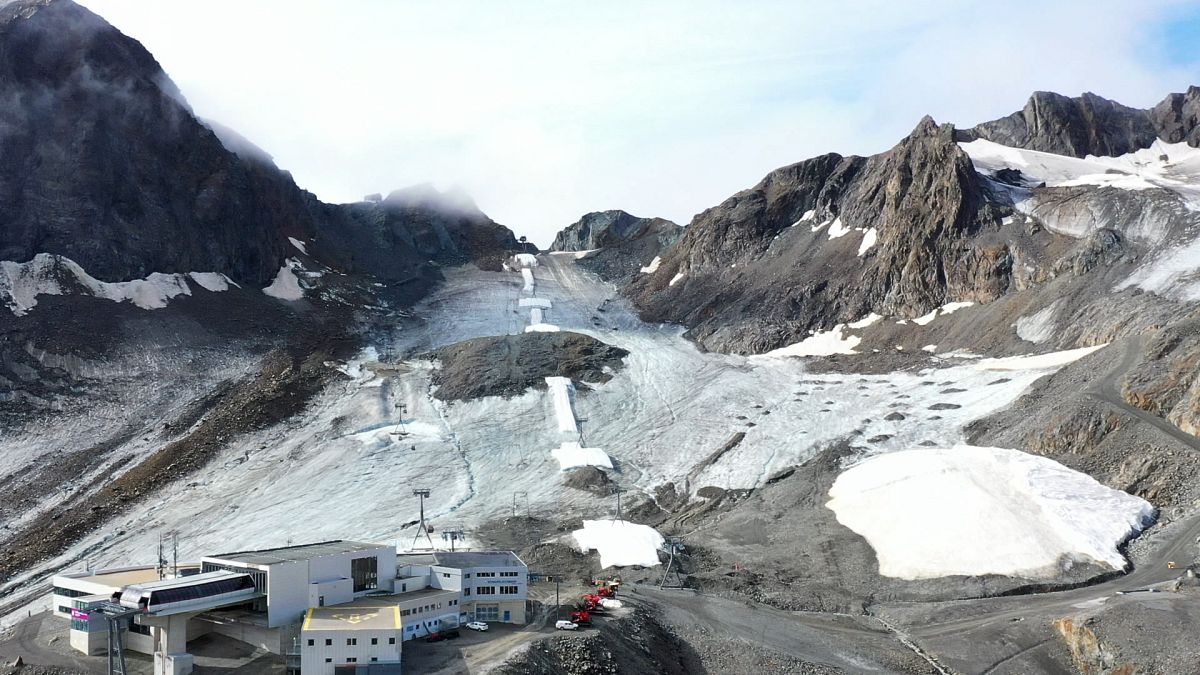What’s changing as Alpine glaciers melt?

In this episode of Climate Now we ask how the Alps are changing as temperatures rise. Melting glaciers mean more sediment in rivers, including potentially harmful substances like uranium and nickel. The rising risk of rockfalls forces high mountain footpaths to be closed.
The sound of melting is all around us as we arrive on the Stubai glacier in Austria. Today the ice may lose a centimetre or two of depth, because the sun is shining and temperatures are well above zero. As we walk slowly from the ski lift, glaciologist Andrea Fischer warns us to watch out for holes and cracks in the icy mud.
Here at an altitude of 2900 metres above sea level, the effects of climate change are obvious to see. The ski station has placed plastic sheeting across a key part of the slope to protect the ice that’s essential for the lifts used by winter tourists. Elsewhere, water trickles away to the valley below, and in the distance, every five minutes or so, we hear the ominous crack of rocks falling down the slope. The stones could easily kill someone, and visitors are kept well away.
Within 20 years this glacier will be gone, like many others in this part of the Alps, which is one of the fastest warming regions of Europe.
“Today we see no snow, no firn, no new ice can form. We have exposed rocks in the middle of the glacier. The glacier has become very thin and will disappear completely in the next few years,” Andrea tells us.
She has been coming here for decades, and happily acknowledges that in the distant past there were trees growing close to where we stand, as the Earth’s climate was warmer due to long-term natural cycles.
However, what’s happening today is nature’s response to human activity. “This change that we are seeing here is 100% due to man-made climate change, which is leading to this very strong glacier retreat since 2000,” she says.
Our visit to the Austrian Tyrol comes as the Copernicus Climate Change Service published data showing that Europe just had its warmest summer on record. The period from June to August was the warmest ever on a global scale, with temperatures 0.7 degrees Celsius above the 1991-2020 average.
The summer period was wetter than average in western and northern Europe, and drier than average in eastern Europe and the Mediterranean.
We head downhill from the glacier to learn more about the effects of the rising temperatures. One of the most far-reaching impacts is the increase in fine sediment in mountain streams as the melting glaciers and thawing permafrost grind the rocks and draw tiny particles down with the water.
The water is almost white, earning it the name Gletschermilch, or Glacier Milk. It looks pretty, but it’s a major headache for the turbines of hydroelectric dams and other water-consuming industries downstream. The fine dust also contains potentially harmful chemicals such as uranium and nickel from within the Alpine rock. These could contaminate water sources, so authorities keep a watchful eye on concentrations.
Thawing permafrost above 2,500 metres has led to a rise in rockslides in recent decades. Such events have always happened here, but they have become more frequent and unpredictable.
Although tourists in the lower valleys can safely enjoy the trails, the head of the mountain rescue team in the village of Galtür says the situation at high altitude is complicated by climate change, particularly the shift from snow to rain.
“It used to be safer because we had a lot more snow. That meant that you could use the ascent routes or an emergency descent route in the snow gullies without rockfalls,” says Christian Walter.
“All that doesn’t exist anymore. And now the emergency descent routes are no longer possible because we have so much rockfall and so much loose rubble that you are no longer safe.”
Such dangers may only last a few decades, because once the ice is gone these mountains will be covered by stabilising green plants, even at high altitude.
As Andrea Fischer says, the Alps are changing colour: “We now have a switch from white to a dark grey and that will soon turn green. Even from space with remote sensing you can already see the greening of the Alps. It will be lush green in all altitude zones.”
Source: Euro News














